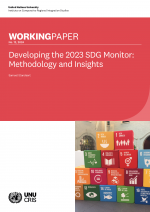Where Did They Come From, Where Did They Go? Bridging the Gaps in Migration Data

Many research analyses monitoring the patterns and evolution of international migration would benefit from high-frequency data on a global scale. However, the presently existing databases force a choice between the frequency of the data and the geographical scale. Yearly data exist but only for a small subset of countries, while most others are only covered every 5 to 10 years. To fill in the gaps in the coverage, the vast majority of databases use some imputation method. Gaps in the stock of migrants are often filled by combining information on migrants based on their country of birth with data based on nationality or using ‘model’ countries and propensity methods. Gaps in the data on the flow of migrants, on the other hand, are often filled by taking the difference in the stock, which the ’demographic accounting’ methods then adjust for demographic evolutions.
This paper proposes a novel approach to estimating the most likely values of missing migration stocks and flows. Specifically, we use a Bayesian state-space model to combine the information from multiple datasets on both stocks and flows into a single estimate. Like the demographic accounting technique, the state-space model is built on the demographic relationship between migrant stocks, flows, births and deaths. The most crucial difference is that the state-space model combines the information from multiple databases, including those covering migrant stocks, net flows, and gross flows.
The result of this analysis is a global, yearly, bilateral database on the stock of migrants according to their country of birth. This database contains close to 2.9 million observations on over 56,000 country pairs from 1960 to 2020, a tenfold increase relative to the second-largest database. In addition, it also produces an estimate of the net flow of migrants. For a subset of countries –over 8,000 country pairs and half a million observations– we also have lower-bound estimates of the gross in- and outflow.




